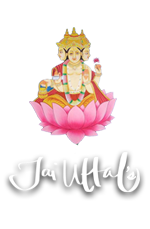Kirtan is the calling, the crying, the reaching across infinite space — digging into the heart’s deepest well to touch and be touched by the Divine Presence.
Kirtan is singing over and over the many names of God and the Goddess, the multi-colored rainbow manifestations of the One. It is said that there is no difference between the name and that which is being named, and as the words roll off our lips in song, the Infinite is invoked, invited, made manifest in our hearts.
Kirtan is part of an ancient form of Yoga known as Bhakti, or the Yoga of Devotion. But in Bhakti we redefine “devotion”, we expand the meaning to include every shade of color in the palette of human emotion, turned towards God through song, dance, and worship. These chants have been sung for millennium by sages, sinners, devotees, and the great primordial yogi alchemists of old. And, as we sing, we touch the spirits of the millions of people across the centuries who have sung the same songs and cried the same tears. As we sing, we immerse ourselves in an endless river of prayer that has been flowing since the birth of the first human beings, longing to know their creator.
Kirtan is a vessel that can hold love, longing, union, separation, lust, despair, mourning, anger, hate, sadness, ecstasy, and oneness. Powered by the fire of these emotions, the chants of Bhakti become like a ship, singing us to the other shore. In lightness, in darkness, in despair, in joy we sing the names — The Name — and turn our human hearts toward the One, who is closer to us than our own breath. Kirtan is food for the spirit, a life raft of song.
Kirtan is for all people. There are no masters of kirtan, no experts, no teachers, no advanced students, no beginners. The practice itself is the teacher, guiding us to ourselves. Kirtan teaches itself by allowing us to enter into a mystery world — a world where all the logic of our minds, all the conditioning and learning are left outside — and we allow ourselves to expand into the mystery.
And in this mystery, we create a temple inside of our hearts, a place of refuge, a place of love, a place of being, a place of sanctity… whatever we need.
There is no right or wrong way to sing kirtan. Kirtan can be breathtakingly beautiful, the music can be stunning and masterful; and it can be cacophonous, dissonant, and almost painful to the ears. Aesthetics don’t matter. All that matters is the spirit, the feeling. Don’t worry about what you sound like, feel whatever you feel, have no expectations, no inhibitions. Kirtan is an oil well digging deeper and deeper into the heart. A power tool of love and longing. A train carrying us home. Make these kirtans your own prayers and use their power to set fire to your own soul. We sing together and each person has a totally unique, individual experience. Yet by singing together we give strength, safety and passion to each other, and give ourselves permission to sing and dance freely, releasing and expressing through our voices and bodies, the emotions tightly locked in our hearts. The pain of separation is one with the bliss of union.
And finally kirtan is an offering, a gift to the great One who has given us everything, and to whom we can give nothing in return but our loving remembrance.

